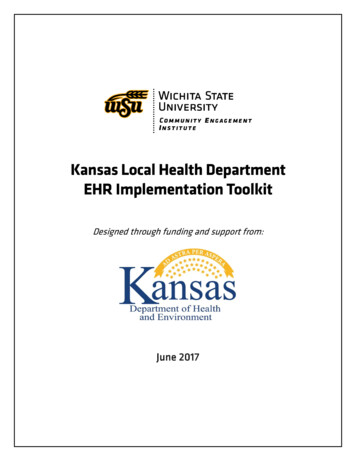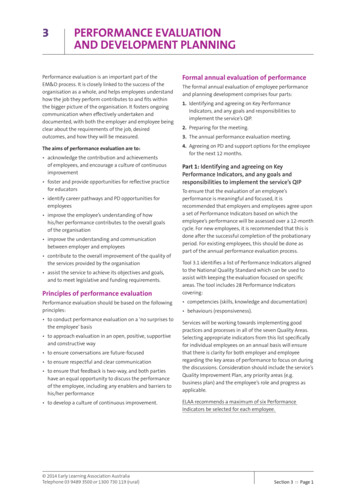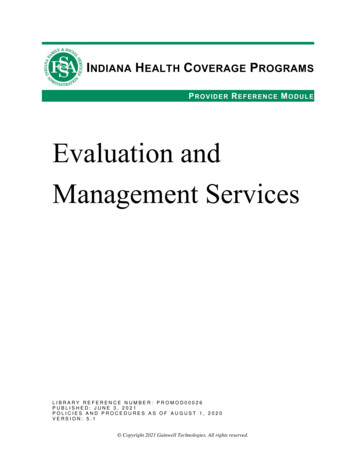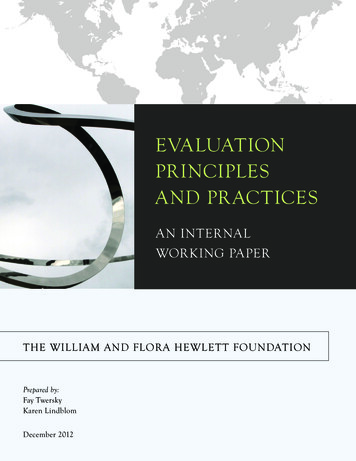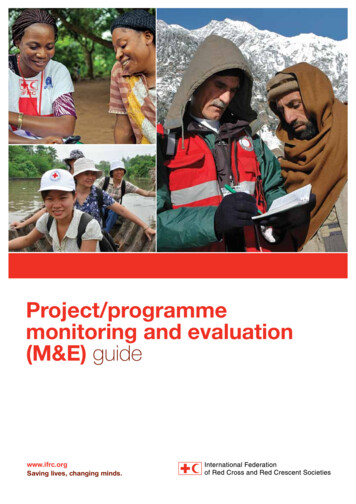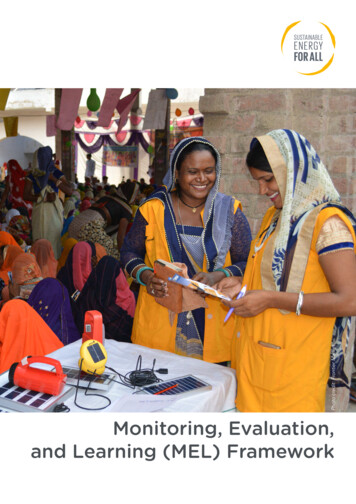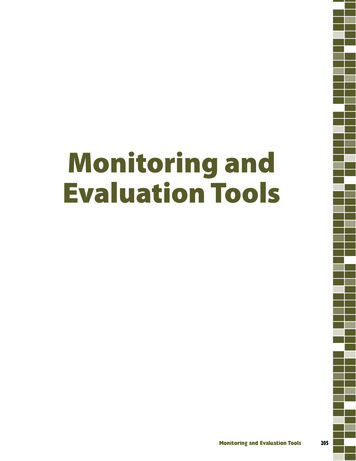
Transcription
Monitoring andEvaluation ToolsMonitoring and Evaluation Tools205
206Influenza Division International Activities Fiscal Year 2011 Annual Report
MONITORING AND EVALUATIONUnder the cooperative agreements made between the U.S. Centers for Disease Control and Prevention’s(CDC) Influenza Division and its partner countries, the Division supports the monitoring and evaluation(M&E) of activities associated with international Influenza program implementation. The purpose of M&Ein this context is to: Demonstrate accountability for the resources used by programs to key stakeholders; CDC and thecountries which receive funding. Document each country’s capability and capacity for influenza surveillance, diagnostics andpandemic preparedness in order to:ˏˏ identify program strengths and opportunities for improvement.ˏˏ provide a mechanism to measure progress toward defined objectives and therebydemonstrate meaningful improvement in public health function over time. Guide ongoing investment in influenza surveillance, diagnostics and pandemic preparedness globally. Inform strategic and programmatic planning for countries and target technical assistance providedby CDC. Standardize and systematize practices. Identify good practices that can be shared between countries.The Influenza Division has developed three tools which are described below. Countries participatevoluntarily in these assessments.National Inventory of Core Capabilities for PandemicInfluenza Preparedness and ResponsePurpose: The National Inventory of Core Capabilities for Pandemic Influenza Preparedness and Response(National Inventory) is a comprehensive tool by which countries can systematically and quantitativelymeasure their capability and capacity to respond to an influenza pandemic.Structure and content: The National Inventory covers 12 distinct domains, defined as ‘core capabilities’and each capability is assigned a composite score based on the quality, coverage and timeliness of fourrelated indicators. For example, the core capability of ‘Infection Control’ is measured by determiningperformance in the following indicators (i) standards of infection control by level of health-care system (ii)integration of infection control training for staff (iii) availability of logistical resources for infection controland (iv) level of institutionalization of infection control efforts. The end-points for the core capabilities arenot identical which allows for variation in public health priorities across countries with differing resourceconstraints. For a copy of the National Inventory, please visit tion: Between May and October of 2008, 40 countries completed baseline self-assessments,facilitated by CDC staff. A further 12 countries participated in late 2009 and early 2010 to establishbaselines. As of November 2010, 36 countries of the initial 40 countries which participated had repeatedthe tool after an approximate two year interval, allowing for comparing baseline and subsequent scores.From 2012 onwards, a new round of data collection will take place.Monitoring and Evaluation Tools207
Outcomes: Comparison of data collected and analyzed for the 36 countries completing self-assessmentsbetween 2008 (baseline) and 2010 revealed the following: Total (aggregate) scores for the tool moved in a positive direction indicating an overallimprovement in pandemic preparedness for each country over the period. Looking at all countries in aggregate, all 12 core capabilities showed statistically significantimprovement from baseline. Examining each indicator in aggregate, 47 of 50 indicators showed statistically significant progressfrom 2008 to 2010.Further to this:208 The assessments in 2008 helped countries to identify and target areas for preparednessimprovement which in turn strengthened their ability to respond to the 2009 H1N1 pandemic. At the same time, the 2009 outbreak offered an enormous opportunity for countries to test theirpandemic response with the outcomes captured when they repeated the tool in 2010. Identifying areas for Influenza improvement is also enhancing capacity-building for otherinfectious diseases as well as encouraging compliance with International Health Regulations 2005(IHR). Using the tool to document progress is helping countries advocate for continued support.Influenza Division International Activities Fiscal Year 2011 Annual Report
International Influenza Laboratory Capacity Review ToolPurpose: The International Influenza Laboratory Capacity Review Tool (IILCRT) is designed for assessingthe capability and capacity of an influenza laboratory to perform influenza diagnostics.Structure and content: The IILCRT is a series of questions divided into nine sections for assessinglaboratories across a wide variety of influenza laboratory functions including, general laboratory functions,virology and molecular biology techniques, availability and maintenance of equipment, specimen handling,collection and reporting, staff training, laboratory safety and methods for quality assurance and qualitycontrol. The results from these sections form the basis for creating laboratory capacity summary reportsand recommendations for countries. The structure and content of the tool was updated in 2011 for clarityand to include additional questions. For a copy of the tool, please visit tion: Between September 2009 and October 2010, national laboratories in 33 countriescompleted baseline assessments, facilitated by staff from CDC and the Association of Public HealthLaboratories (APHL). National laboratories in four additional countries have been assessed in FY 2011 witha further 6 countries assessed at baseline undergoing repeat assessments in the same period. From FY 2012laboratories will be assessed using the updated version of the IILCRT.Outcomes: The tool serves to highlight overall laboratory strengths while recommendations are providedby reviewers where opportunities for improvement present themselves. For example, a training needsassessment based on the first 26 laboratories reviewed, identified, six country laboratories in the Africaregion which do not perform virus isolation; all of which expressed interest and readiness to receivetechnical assistance in these methods. Likewise, across all regions, many countries have received specificrecommendations for improving the biosafety of their laboratories. As a consequence, APHL, CDC, theNational Institute for Communicable Diseases in South Africa, the National Institute of Health in Thailand andthe WHO Collaborating Centers for Reference and Research on Influenza in Melbourne and China deliveredthe first course on “Improving Influenza Laboratory Management Practices”, in Johannesburg in 2011.Analytic Framework: During FY 2011, CDC and APHL further developed the IILCRT by adding aquantitative component to the analysis of data collected through the assessments. A quantitative analysisof the data can be presented visually allowing quick identification of the status of an influenza laboratory’scapacity. It can also provide a standardized approach to tracking changes in laboratory capacity over time.Approximately 150 questions have been selected for analyzing laboratory capacity across eight categorieswhich have been identified as critical to the functioning of a national influenza laboratory. The eightcategories for analysis include: National Influenza Center (NIC) Criteria, Laboratory Management, Biosafety,Quality Assurance and Quality Control, Molecular Biology, Virology, Specimen Handling, Collection, andReporting and Equipment. Each selected question has been assigned one point. The points are aggregatedby category and converted to a percentage performance measure. Beginning in 2012, each laboratory willreceive a summary report of the quantitative analysis in addition to the full report. Data collected in 2009through to 2011 will be analyzed retrospectively using the new analytic framework.Monitoring and Evaluation Tools209
International Influenza Surveillance Assessment ToolPurpose: The International Influenza Surveillance Assessment Tool (IISAT) is designed to standardize andsystematize the review of national surveillance systems. The tool helps CDC and partners to clarify theobjectives and structure of their surveillance systems, such that recommendations and technical assistancecan be targeted to meet system goals such as, conducting data quality checks and establishing built-inlaboratory and epidemiologic data integration.Structure and content: The IISAT consists of six checklists covering national, central and sentinelsite levels and covers all ILI and SARI related surveillance. For example, it includes a review of datamanagement, analysis and reporting procedures. The tool uses a standard format for creating surveillancecapacity summary reports where recommendations for countries can be provided. For a copy of the tool,please visit tion: Between March and September 2010, the IISAT was piloted in three countries by CDCstaff, with an additional seven reviews completed that year. A further eight countries have undergonesurveillance reviews during FY 2011. In FY 2011, CDC’s Influenza Division entered into a cooperativeagreement with the Council of State and Territorial Epidemiologists (CSTE) who have providedepidemiologists to assist with conducting reviews in partner countries and will continue through FY 2012.Outcomes: Reviews in pilot countries in 2010 were used to refine and finalize the tool. The tool hasserved to highlight overall surveillance strengths and challenges with recommendations for improvementprovided to the 18 countries reviewed to date, nine of which took place in FY 2011. Recommendationshave included: weekly and quarterly analysis of risk factor data, dissemination of data to stakeholders, andbetter coordination between national staff and sites.Covers of three monitoring and evaluation tools used for International Influenza Programs. From left to right: The International Influenza Surveillance Assessment Tool, theInternational Influenza Laboratory Capacity Review, and the National Inventory of Core Capabilities for Pandemic Influenza Preparedness and Response.210Influenza Division International Activities Fiscal Year 2011 Annual Report
Under the cooperative agreements made between the U.S. Centers for Disease Control and Prevention’s (CDC) Influenza Division and its partner countries, the Division supports the monitoring and evaluation (M&E) of activities associated with international Influenza program impl




